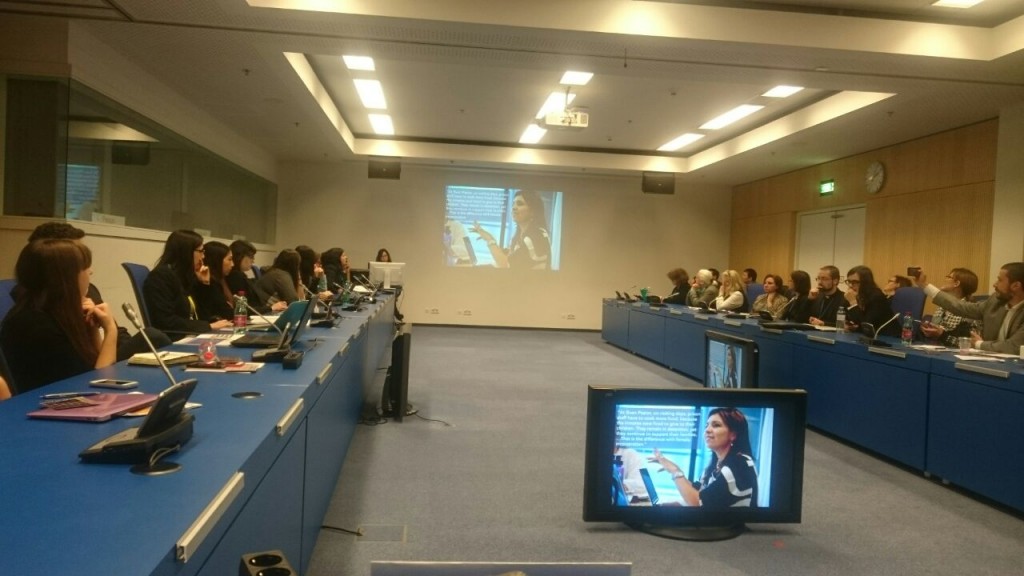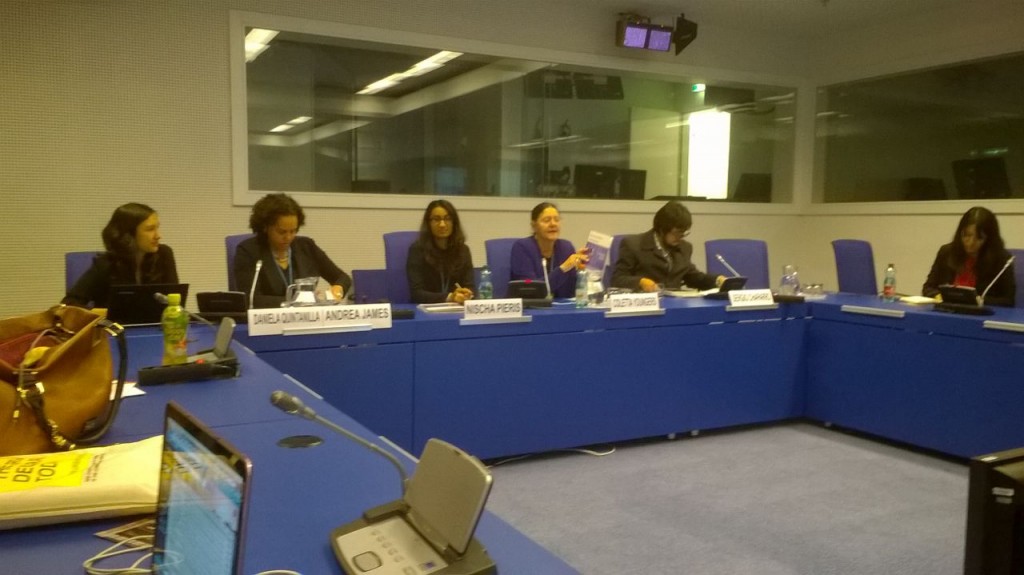Coletta Youngers, WOLA/IDPC. We are here to launch this guide on women and incarceration. It is the result of the work of a group of experts, governments, academics and NGOs to reduce the incarceration of women for drug offences. We are lucky to have women here who were part of the group. The postcard available here has a link to the webpage where you can download materials on the project and a photo project of women incarcerated. First we will have Sergio Chaparro, principal investogator at the Colombian human rights NGO DeJusticia and is also a member of the CEDD on the issue of drug policy and incarceration in Latin America.
Sergio Chaparro, Dejusticia. I will present the latest report of the CEDD. Nobody truly knows a nation until we have been inside its prisons. Countries in the Americas are not good countries at all if you look at prisons. How many of us know what it is to live behind bars and how to survive after this experience? Drug conventions have been implemented through drug laws following wrong trends – focusing on heavily punitive responses and incarceration, with less emphasis on humane and cost-effective tools including alternatives to prison. Secondly, criminal penalties have been expensive. Criminal penalties have been implemented as a one size fits all all those involved in drug trade the same way. It is an addiction to punishment. The International Centre for Prison Studies shows that countries in the region have about 38% of prison overcrowding. In a sample of 9 countries, 1 in 5 inmates are in prison for drug offences. It puts in question the current international drug policies. The incarceration of people for drug offences is at a higher rate than the growth in the overall prison population. Most are involved in the lowest levels of the drug trade. Among other things, this increases levels of violence in prisons and bad conditions, hinders education and employment. Special Rapporteurs concluded that prison overcrowding constitutes inhumane treatment. Drug policy conflicts with respect for human rights. According to the UN charter, human rights must prevail. The average rate of overcrowding would fall from 56% to 26% if we reviewed drug policies.
Right to life: the prevalence of HIV, TB and hep is much higher in prison, can be up to 25% higher in some Latin American countries. Severe punishments against drug use and possession for personal use mostly target the most vulnerable, even though there have been clear UN guidelines on the need to stop criminalising drug users. Authorities from the criminal justice system are those deciding whrther the person is a user or a dealer – police, prosecutors and cirminal courts.
The situation of women is particularly worrying. They are young, poor, single mothers caring for many children and family members. In Colombia, 93% of women in prison had children.
We can change these realities – Costa Rica has reviewed its drug laws to reduce incarceration sentences for women introducing drugs in prison.
Daniela Quintanilla, Corporacion Humanas Chile. Prison is by definition a male space, with few women incarcerated. But drug offences represent the 2nd cause of incarceration for women. We interviewed 49 women. 48 were women, they had low levels of education, poor, homeless and involved in the illicit economy. Patterns of involvement included the following:
- social and economic vulnerability with no way to feed their families
- problematic dependence of drug use, many lived in the street and engaged to support consumption
- intimate partners of drug traffickers, involved with male partners at a very young age
- engaged in trafficking of drugs through a family business
- entrepreneurship: the drug business represents an economic opportunity, to spend extra money on their kids with just one job that has flexible hours. Selling drugs allowed them to have a better life, but remain very poor.
- Framing: most women interviewed declared they were innocent and framed.
We also analysed court proceedings. We found gender prejudice that could be easily identified. Women are expected to be good, nurturing and caregiving. It is a natural act. Alternatives to incarcerations are often disregarded for women with kids or pregnant as they are particularly stigmatised and often given even harsher sentences. In addition, judges ask why we should now care of kids if the mothers didn’t care about them when they engaged in the crime… During trial, most women did not meet their lawyer or have adequate legal defence. Most women did not understand the court proceedings they were facing.
Another aspect of gender stereotype is that in an alarming number of cases women are condemned for crimes committed by others. This does not happen in any other kind of crimes.
The number of women in prison increases all over the world. This can be an outcome of a tough on drugs policies. But do numbers reflect success in anti-drug fight? The answer is no. Women are easily replaced. The gender perspective is completely absent in drug policies. We need to include this perspective in the debate for effective drug policies.
Coletta Youngers, WOLA. Sentenced to 24 months to federal prison, has organised an impressive network of women incarcerated or formerly incarcerated in the USA.

Andrea James, Justice as Healing. Thanks to WOLA for including a representative of affected populations – nothing about us without us. Increase in incarceration results in harms for black women globally. It is incredible to come from a community of black women and see this as a global issue. The issue of black women and increases in incarceration is clear when you hear stories of women. Drug control is build on racism and social control of black people. We live in unequal justice systems. We start with acknowledging racism and white supremacy in treating people differently. A white majority knows this is wrong but do nothing to promote human rights for black people. Looking at women, poor, black, caught in this racial cast-based criminal justice system show trauma and pain for who they are, even as girls. We are asked mostly as formerly incarcerated women to share our stories to talk about that. But poor women of colour caught in the justice system have been telling their stories for years and the policy continues to ignore their needs by using incarceration as a default, separating them from their children. We still tell our stories, particularly to women, as there is a lot of pain involved in just being a woman in our society. Even privileged women share the pain of our sisters. It is evident that the increasing number of black women chained and shackled brought in front of judges every day. We want to bring the voice of people most affected by failed drug policies and identify what could change. We want to show what it’s like to live in a prison, separated from families, and trauma. But we are also policy experts – we want to be at the policy making table. Sharing our stories helps addressing the root of the problem – racism. As we organised ourselves as policy makers, most imortant is organising ourselves to heal ourselves and our children. As collective sisterhood, we can empower ourselves through healing.
Nischa Pieres, OAS Inter-American Commission on Women. I want to reiterate that the creation of this working group included governments and NGOs, but we also wanted to include the voice of incarcerated and formerly incarcerated women. We have learned from the previous panellists the impact of punitive drug laws. Most women have children and sole providers of their families. They usually leave them without any support.
Quick overview of the objectives of the guide: we started it with the understanding that current drug policies have led to the excessive incarceration of women. Most of them are involved in non-violent and low-level crimes. We must reconsider our policies to incorporate a gender perspective. The purpose of the guide is to reduce the incarceration of women. We don’t directly deal with women in prison, but we do address women with children as most women incarcerated for drug crimes are women with children and no recourse to public funds.
Our guiding principle is that prison should only be used as a last resort. Gender mainstreaming should be incorporated in drug policy design and implementation. And women affected should be included in policy and implementation.
We divided the guide into seven key aspects, I will mention a few here:
- decriminalising drug users is key, criminalisation means that women will continue to be discriminated and stigmatised. Use, possession and cultivation for personal use should not be criminalised.
- Another important component of the guide is proportionality of sentencing. Most crimes committed by women are low-level and non-violent. We must also consider a number of mitigating factors.
- We must put an end to excessive use of pre-trial detention. Pregnant women should never be held in pre-trial detention.
- Alternatives to incarceration from a gender perspective are essential for drug related crimes, focusing instead on economic autonomy and social integration with opportunities for education and employment in the formal economy. This has been the case in Costa Rica for example with the law reform and reintegration programmes. We must also remove all legislative and practical obstacles that keep people who commit drug offences from benefiting alternatives to prison. First time offenders should not be sent to prison. And women with children/pregnant should not be incarcerated for non-violent drug offences.
We also have additional resources on this issue, including a report on alternatives to incarceration, another on innovative approaches related to the recommendations of the guide, a document on data collection and analysis, a series of photo essays of women deprived of liberty for drug offences, and country-specific guides to apply recommendations to the national legal context.
Virginia legislative system. I work with the criminal justice system and they love incarceration. But there is no way fro NGOs to get access to the information on women incarcerated.
Andrea. We convened a group of women formerly incarcerated and have collaborated with Universities to bring the voice of women outside of prisons. We held panel discussions with women in prison, but they were then punished. They knew that would happen but they did this to show what would happen to them if they engaged in the issue. We have some very successful projects to open the dialogue with prison administrators.
Deborah Small, National Advocates for Pregnant Women. For me, issues of reproductive rights and gender violence are essential to understanding the impact of drug policy on gender. We must acknowledge that part of drug policy and the intersection between sexual violence against women as a tool of war, economic vulnerability and other factors that are key factor in women’s involvement in the drug trade. We need a holistic approach to women inequality. We have drafted an UNGASS declaration on the impact of drug control on women. We call for economic justice, reproductive justice and the need to end the war. Please sign on to the website and sign the declaration.
Dianova International. We are organising a side event on women, drugs and development next week – please ask us if you wand more information.
Coletta Youngers, WOLA. I now want to show you one of our photo essays from a woman incarcerated in Buen Pastor in Costa Rica. The essay is available here.
